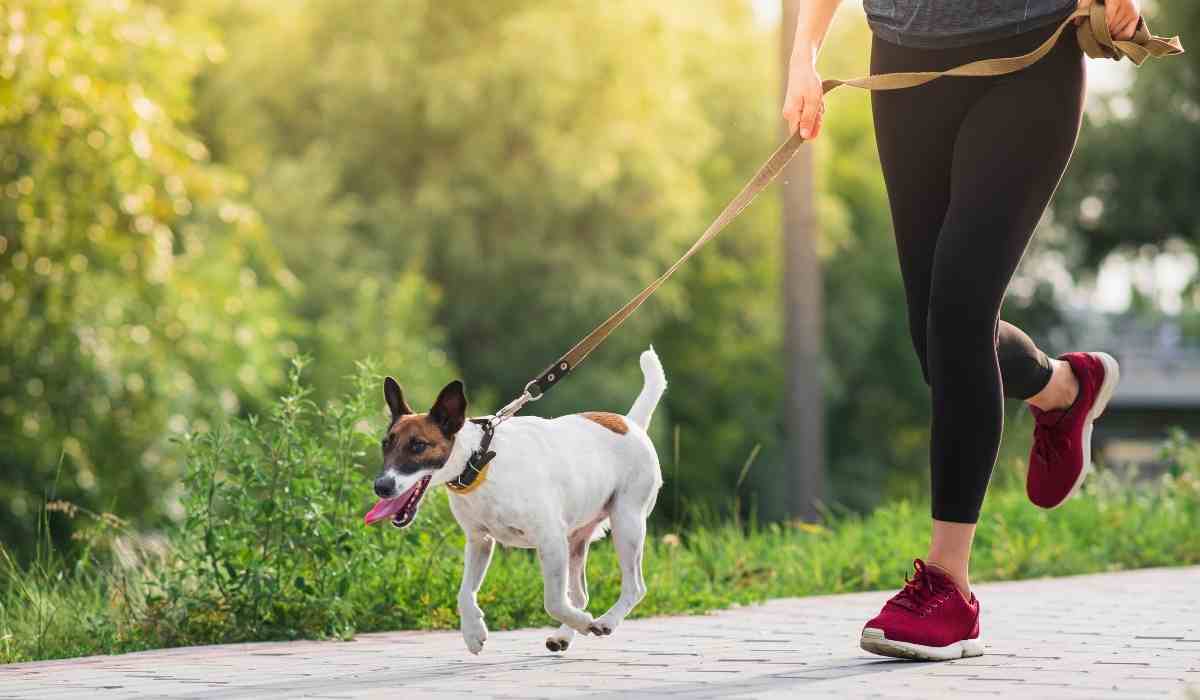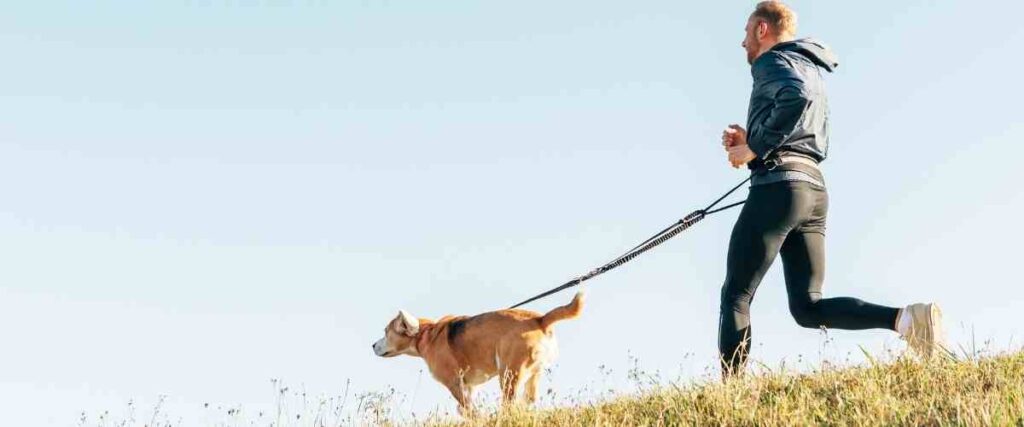
Running With Your Dog: Do’s and Don’ts
- What are the benefits of running with your dog?
- Consider your dog’s age, health, and breed.
- Prioritize basic obedience training.
- Start slowly.
- Be willing and ready to stop mid-run.
- Run early to avoid the heat.
- Consider running on dirt trails.
- Use sun and bug protection.
- Watch your dog’s body language closely.
- Don’t forget the waste bags.
- Key Takeaways:
Dogs are excellent running partners. They have boundless energy, are always ready and waiting at the door, and can enhance feelings of safety while running on trails or through the city. However, there are a few do’s and don’ts to ensure a good running experience for you and your pup.
What are the benefits of running with your dog?

If you’ve never considered all the benefits of running with your dog, there are plenty!
- It’s a fun and healthy activity for both of you.
- Your dog is an excellent motivator. We’ve never met a dog that didn’t want to go for a run.
- It’s a great way to keep your and your pup’s weight in check.
- Running alongside your dog may help prevent dangerous interactions with strangers while running.
- Your dog is more likely to be well-behaved because you’ve given them a chance to work out their energy.
Despite all the benefits, you’ll want to consider a few basic do’s and don’ts before you can start running.
Consider your dog’s age, health, and breed.

Like many other dog owners, you may have asked yourself, “Is it okay to run with my dog?” If so, the answer is: It depends!
Certain breeds make fantastic running companions, but others aren’t well suited to the sport. Other dogs don’t enjoy running or may be predisposed to overheating. For example, giant or toy breed dogs typically don’t do well with running. The same goes for short-nosed breeds like bulldogs, pugs, and Boston terriers. However, if you have a labrador retriever, dalmatian, or Australian shepherd, these breeds tend to be great runners.
Additionally, if your dog is still very young, its joints aren’t fully developed yet and may not be able to withstand the strain of running. Puppies are also more prone to injuries. Conversely, older dogs may have joint issues, making them more susceptible to injuries or pain.
It’s always a good idea to check with your vet before you start running with your dog. They can help you determine if your pup is an ideal running companion or if it would be better to find a different activity to do together.
Suppose your puppy isn’t up to running with you; no worries! You can still run with a virtual furry friend using Vingo! Choose from one of our cute fur pals when you customize your avatar, and they’ll run or ride along with you as you traverse the various routes on Vingo.
Prioritize basic obedience training.

Obedience training will keep both you and your dog safe while you’re out running together. Teaching your dog a few basic commands will also ensure that the running experience is more enjoyable for you, too.
For instance, your pup should know how to walk and run on a loose leash before you attempt to run with them on a shorter leash. They should also know how to turn with you as you navigate more curvy routes.
If you run in an off-leash area, you should also be able to trust that your dog will come back to you if you call them.
Start slowly.

Just as you need some time to develop your endurance and cardiovascular health when you first start running, your dog requires the same. Warm up with a short walk and then start by running a short distance first. Once your dog has adjusted to the demands of that, you can gradually increase the length or duration of your runs.
Be willing and ready to stop mid-run.

You’ll need to anticipate stopping for potty and water breaks often while running with your dog. If you can, take a few minutes to warm up before your run and give your dog a chance to use the bathroom before you start.
Once you get going, plan on taking a water break every ten minutes or so. You may even need to stop more frequently if you’re running in hot weather. (More on that topic below.) And, of course, know that if you’re running with your dog, they’re likely to want to stop and smell the roses (literally) often as you go.
If you’re trying to set a new time for yourself or achieve a particular training goal, leaving your pup at home may be best. You can always wait to run with them on a less intensive outing. That way, you won’t get frustrated when your pup wants to stop and smell the third park bench in a row.
Run early to avoid the heat.

Depending on where you live, you might be able to run at all times of the day. However, if you live in an area with sweltering summers, it’s best to plan on running in the early morning, which benefits both you and your dog. Dogs’ paw pads can quickly get burned or injured running on the hot cement, and they can get overexerted or overheated in hot weather, just like humans.
Although it might take some time to adjust to an earlier running schedule, there are plenty of other perks to running first thing in the morning, including:1
- Having more energy throughout the day
- Enhancing focus and cognition
- Reducing the risk of diabetes
- Getting more sound sleep at night
- Boosting your mood
- Reducing stress
Of course, you’ll want to prioritize an early bedtime and a healthy bedtime routine if you plan to run early in the morning. Otherwise, you might find the early runs to be too exhausting.
Consider running on dirt trails.

Running on asphalt can be hard on your dog’s joints and paws. Instead, consider heading out to the dirt trails near your home. You and your pup will enjoy nature’s sights, sounds, and smells as you explore on or off-leash trails at your leisure.
Before you run on any trail, make sure you know where you’re going or grab a map so you don’t get lost, especially if you’re new to the area! It’s easy to get turned around on heavily wooded trails that wind through the forest or other wild landscapes.
Use sun and bug protection.

The bugs might be intense depending on where and when you run with your dog. In addition to wearing sunscreen and bug spray, don’t forget that your dog needs protection too! Spending time running outdoors puts your dog at risk of picking up ticks and other harmful bugs and parasites. Before you head out, ensure your dog is up to date on their flea and tick medication.
After completing a run through the forest or long grass, thoroughly inspect your pup’s fur once you get home, too. If you find any ticks, remove them immediately and reach out to your vet if your dog gets bitten. Tick bites can cause a host of painful or life-threatening diseases in dogs, so it’s better to be safe than sorry.
Watch your dog’s body language closely.

Keep a close eye on your dog’s behavior during and after your run to make sure they’re not suffering from overexertion or heatstroke. Common signs can include:
- Excessive drooling
- Vomiting
- Excessive or long-lasting panting (like they can’t catch their breath)
- Lethargy
- Weakness
- Bloody diarrhea
- Trying to stop or lie down
- Seeking out shade
Sometimes, your dog may want to lie down. In this case, don’t force them to keep running. Call it quits and get them somewhere where they can rest. If you notice any of these other signs of exhaustion, make sure they have some water and allow them to rest. If their symptoms don’t improve, call your vet.
Don’t forget the waste bags.

No one enjoys stepping in dog poop while walking or running. Make sure you have the right gear to clean up after your dog and transport the waste to the nearest trash can. Small waste bags are easy to carry along with you in your pockets, tied around your dog’s leash, or in a small, portable canister that attaches to your leash or water bottle.
Key Takeaways:
Running with your dog is an enjoyable experience and can be highly motivating, especially if you prefer to run with a companion. Follow these tips to ensure that both you and your dog have a good running experience and everyone stays safe.Sources:
- UHealth Collective. (2021, September 21). The Benefits of Morning Workouts. University of Miami Health System. https://news.umiamihealth.org/en/the-benefits-of-morning-workouts/








